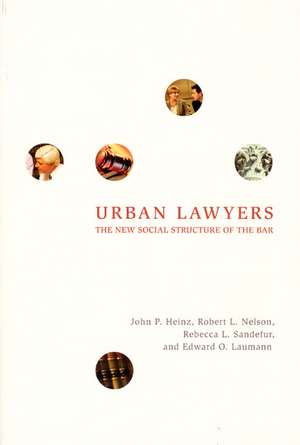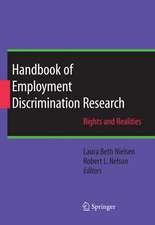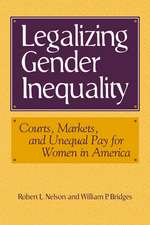Urban Lawyers: The New Social Structure of the Bar
Autor John P. Heinz, Robert L. Nelson, Rebecca L. Sandefur, Edward O. Laumannen Limba Engleză Paperback – 4 iul 2005
Over the past several decades, the number of lawyers in large cities has doubled, women have entered the bar at an unprecedented rate, and the scale of firms has greatly expanded. This immense growth has transformed the nature and social structure of the legal profession. In the most comprehensive analysis of the urban bar to date, Urban Lawyers presents a compelling portrait of how these changes continue to shape the field of law today.
Drawing on extensive interviews with Chicago lawyers, the authors demonstrate how developments in the profession have affected virtually every aspect of the work and careers of urban lawyers-their relationships with clients, job tenure and satisfaction, income, social and political values, networks of professional connections, and patterns of participation in the broader community. Yet despite the dramatic changes, much remains the same. Stratification of income and power based on gender, race, and religious background, for instance, still maintains inequality within the bar.
The authors of Urban Lawyers conclude that organizational priorities will likely determine the future direction of the legal profession. And with this landmark study as their guide, readers will be able to make their own informed predictions.
Drawing on extensive interviews with Chicago lawyers, the authors demonstrate how developments in the profession have affected virtually every aspect of the work and careers of urban lawyers-their relationships with clients, job tenure and satisfaction, income, social and political values, networks of professional connections, and patterns of participation in the broader community. Yet despite the dramatic changes, much remains the same. Stratification of income and power based on gender, race, and religious background, for instance, still maintains inequality within the bar.
The authors of Urban Lawyers conclude that organizational priorities will likely determine the future direction of the legal profession. And with this landmark study as their guide, readers will be able to make their own informed predictions.
Preț: 258.83 lei
Nou
Puncte Express: 388
Preț estimativ în valută:
49.53€ • 51.32$ • 41.34£
49.53€ • 51.32$ • 41.34£
Carte tipărită la comandă
Livrare economică 21 martie-04 aprilie
Preluare comenzi: 021 569.72.76
Specificații
ISBN-13: 9780226325408
ISBN-10: 0226325407
Pagini: 352
Ilustrații: 43 line drawings, 10 tables
Dimensiuni: 152 x 229 x 25 mm
Greutate: 0.54 kg
Ediția:New.
Editura: University of Chicago Press
Colecția University of Chicago Press
ISBN-10: 0226325407
Pagini: 352
Ilustrații: 43 line drawings, 10 tables
Dimensiuni: 152 x 229 x 25 mm
Greutate: 0.54 kg
Ediția:New.
Editura: University of Chicago Press
Colecția University of Chicago Press
Notă biografică
John P. Heinz is the Owen L. Coon Professor of Law at Northwestern University and senior research fellow at the American Bar Foundation. He is coauthor with Edward O. Laumann of Chicago Lawyers: The Social Structure of the Bar. Robert L. Nelson is professor of sociology at Northwestern University and director of the American Bar Foundation. Rebecca L. Sandefur is assistant professor of sociology at Stanford University. Edward O. Laumann is the George Herbert Mead Distinguished Service Professor of Sociology at the University of Chicago.
Cuprins
Contents
List of Tables and Figures
Preface
Part I The Professions of the Bar
Chapter 1 Chicago Lawyers Revisited
Prior Research
The Data
The Issues
Chapter 2 The Changing Character of Lawyers' Work
with Ethan Michelson
The 1975 "Two-Hemispheres" Finding: Methodological Issues
1995 Patterns of Co-practice
Specialization by Field
Client Differentiation by Field
Allocation of Time in 1975 and 1995
Conclusion
Chapter 3 Integration and Separation
Integrative Mechanisms
Bar Associations
Law School Stratification
Ethnoreligious Differences
Race, Gender, and Family Background
Practice Setting
Structure and Opportunity
Part II The Hierarchies of the Bar
Chapter 4 Prestige
Three Theories of Honor
Prestige
Determinants of Prestige
Core Economic Values, or Professional Purity
Participation in Prestigious Work
Conclusion
Chapter 5 Organizations
The Economic Dominance of Large Law Firms
Organization-Linked Advantage
A Typology of Law Firms
Democracy and Participation
Professional Autonomy
Determinants of Compensation
Changing Management Policies
Organizing Principles
Hours Worked
Task Structure
Change and Continuity
Chapter 6 Careers
with Kathleen E. Hull
Work History and Careers
Career Stability
The Golden Age and Its Fading
Paths to Eminence in the Profession
Lawyers Not Practicing
Conclusion
Chapter 7 Income and Income Inequality
Structural Sources of Inequality
Nonpracticing Lawyers
Individual-Level Correlates of Income
Equal Justice
Part III Lawyers' Lives
Chapter 8 Divided Opinions
with Monique R. Payne
The Chicago Data
Differences among Types of Lawyers
Adaptation to Client Values?
Social Values
Conclusion
Chapter 9 Community Roles
with Paul S. Schnorr
The Chicago Data
Overall Participation
Correlates of Overall Participation
Who Participates Where?
Correlates of Participation by Organization Type
Leaders
Conclusion
Appendix: Period, Age, and Cohort Effects
Chapter 10 Connections within the Bar
The 1975 Networks
The 1995 Networks
The Structure of the Networks
Ethnoreligious and Political Divisions
Conclusion
Appendix: Notables' Biographies (as of 1994<n>95)
Chapter 11 A Satisfying Profession?
with Kathleen E. Hull and Ava A. Harter
Research on Job Satisfaction
The Chicago Findings
Happy Hour at the Bar?
Part IV Transformation
Chapter 12 The Processes of Change
Autonomy and Influence
The Decline of Professional Dominance
Demand
Reasons for Growth
Changes in Firm Structure and Management
Lawyer-Client Relationships
Organizational Boundaries
Business Methods
Conclusion
Notes
References
Index
List of Tables and Figures
Preface
Part I The Professions of the Bar
Chapter 1 Chicago Lawyers Revisited
Prior Research
The Data
The Issues
Chapter 2 The Changing Character of Lawyers' Work
with Ethan Michelson
The 1975 "Two-Hemispheres" Finding: Methodological Issues
1995 Patterns of Co-practice
Specialization by Field
Client Differentiation by Field
Allocation of Time in 1975 and 1995
Conclusion
Chapter 3 Integration and Separation
Integrative Mechanisms
Bar Associations
Law School Stratification
Ethnoreligious Differences
Race, Gender, and Family Background
Practice Setting
Structure and Opportunity
Part II The Hierarchies of the Bar
Chapter 4 Prestige
Three Theories of Honor
Prestige
Determinants of Prestige
Core Economic Values, or Professional Purity
Participation in Prestigious Work
Conclusion
Chapter 5 Organizations
The Economic Dominance of Large Law Firms
Organization-Linked Advantage
A Typology of Law Firms
Democracy and Participation
Professional Autonomy
Determinants of Compensation
Changing Management Policies
Organizing Principles
Hours Worked
Task Structure
Change and Continuity
Chapter 6 Careers
with Kathleen E. Hull
Work History and Careers
Career Stability
The Golden Age and Its Fading
Paths to Eminence in the Profession
Lawyers Not Practicing
Conclusion
Chapter 7 Income and Income Inequality
Structural Sources of Inequality
Nonpracticing Lawyers
Individual-Level Correlates of Income
Equal Justice
Part III Lawyers' Lives
Chapter 8 Divided Opinions
with Monique R. Payne
The Chicago Data
Differences among Types of Lawyers
Adaptation to Client Values?
Social Values
Conclusion
Chapter 9 Community Roles
with Paul S. Schnorr
The Chicago Data
Overall Participation
Correlates of Overall Participation
Who Participates Where?
Correlates of Participation by Organization Type
Leaders
Conclusion
Appendix: Period, Age, and Cohort Effects
Chapter 10 Connections within the Bar
The 1975 Networks
The 1995 Networks
The Structure of the Networks
Ethnoreligious and Political Divisions
Conclusion
Appendix: Notables' Biographies (as of 1994<n>95)
Chapter 11 A Satisfying Profession?
with Kathleen E. Hull and Ava A. Harter
Research on Job Satisfaction
The Chicago Findings
Happy Hour at the Bar?
Part IV Transformation
Chapter 12 The Processes of Change
Autonomy and Influence
The Decline of Professional Dominance
Demand
Reasons for Growth
Changes in Firm Structure and Management
Lawyer-Client Relationships
Organizational Boundaries
Business Methods
Conclusion
Notes
References
Index
Recenzii
"With this twenty-year update, the best snapshot of American lawyers has become a major motion picture. It is theoretically trenchant, methodologically highly sophisticated, and scrupulously careful. Essential reading for anyone interested in seeking to understand the future of the legal profession from a close reading of its immediate past."
--Richard L. Abel, editor of Lawyers: A CriticalReader
--Richard L. Abel, editor of Lawyers: A CriticalReader
"Urban Lawyers is essential for anyone seeking to understand how the American legal profession reached where it is today and to predict where it may be in years to come. From a cautiously scrutinized empirical base of research data and interviews of Chicago lawyers, these accomplished researchers have compiled an authentic overview of the urban bar in the United States."
"An original, provocative study of how the law profession has changed over the past thirty years. The authors argue that this transformation has been driven largely by changes in corporate clients, who over time have grown bigger and have shifted away from manufacturing toward financial and service industries. Lawyers are now more likely to develop specialties and to work in large law firms--trends that have altered their legal work, compensation, and stratification in dramatic ways. Urban Lawyers shows that professions are dynamic institutions that can be changed as their economic and organizational environments are transformed."
"This landmark study of Chicago lawyers documents dramatic changes over two decades: increasing diversity in both social origins and practice settings, accompanied by rising specialization, declining autonomy, and reduced professional authority and integration. Centering attention on the rising influence of large law organizations in shaping legal careers and practice patterns, Urban Lawyers engages the attention of readers interested in modern organizations and professions as well as in the evolution of contemporary legal practice."
"Almost a quarter century ago, John Heinz and Edward Laumann set a new standard for the scientific analysis of major social institutions with their landmark study of the Chicago bar. Urban Lawyers will be indispensable for anyone interested in the legal profession and for scholars throughout the social sciences engaged in the study of how institutions-and the networks, firms, and professions they comprise-evolve over time."
“The empirical data presented in Urban Lawyers provides readers with a clear-eyed picture of the changes that are reshaping the legal profession. . . . Urban Lawyers offers powerful stuff, especially for law students anxious about entering an increasingly difficult marketplace. In a truly important and memorable study, the volume provides a precise and nuanced assessment of the modern legal profession, in all its empirical complexity.”
"Like its predecessor, Urban Lawyers is an excellent and important book. The authors have gathered a vast amount of high-quality data and have painstakingly analyzed it from a variety of angles. The result is a detailed and wide-ranging map of the legal profession during a period of transition. The book will be of great interest to scholars of the legal profession and of the professions more generally. Indeed, it will serve as an indispensable reference point for future research in these areas."













